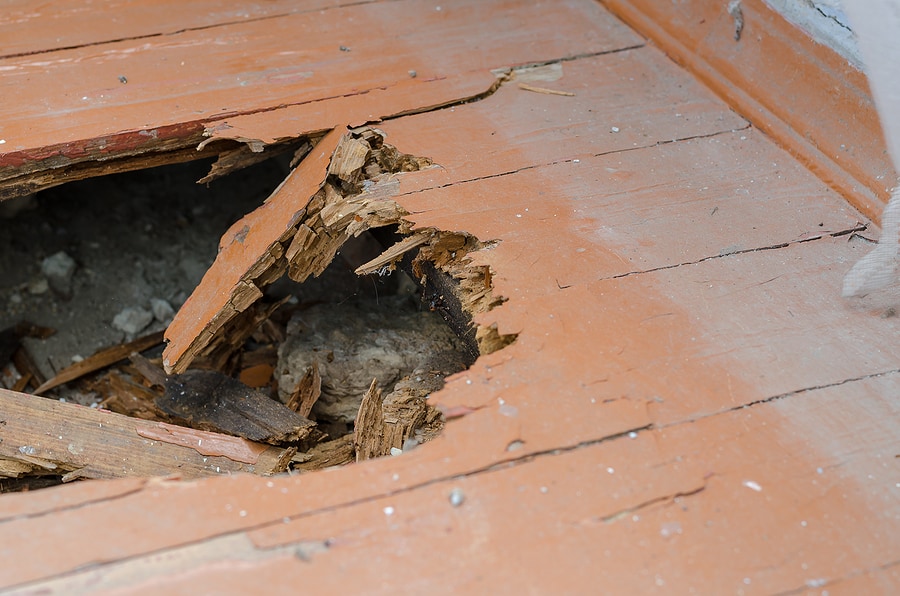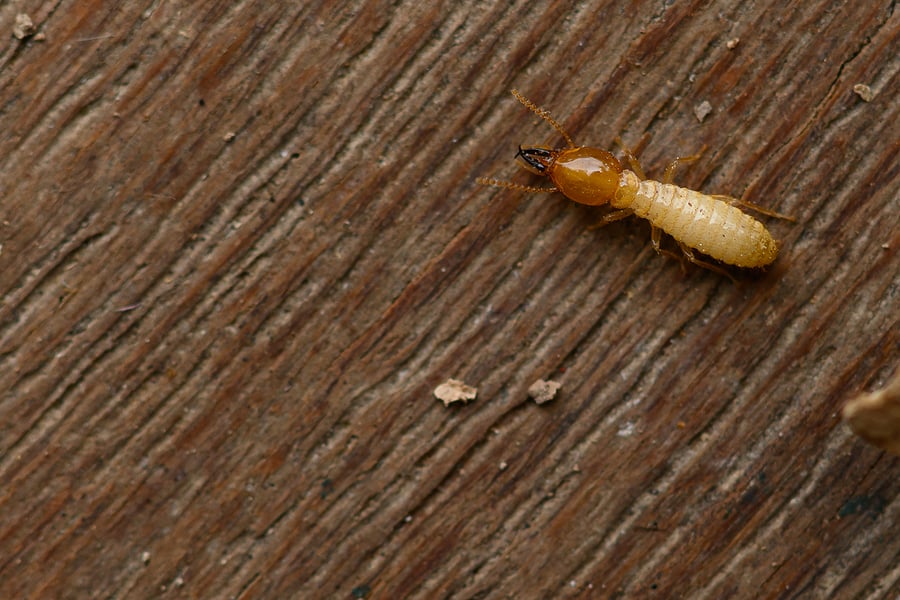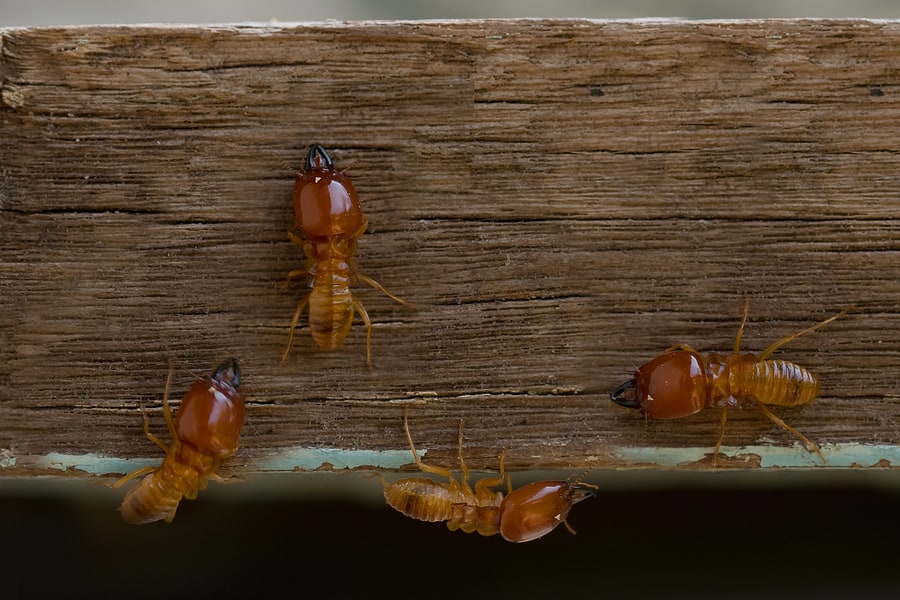READY TO GET STARTED?
REQUEST A FREE ESTIMATE
Fill out the form below or call (855) 789-9807 for a free, no-obligation estimate.

Whether you’re a new homeowner or have lived in your home for years, dealing with a termite infestation can be devastating for all. Unfortunately, termite damage can be costly to repair and not covered by homeowners’ insurance policies. Before termites have taken over your home, it’s important to know the basics of termite signs and treatments.
Termites are considered silent destroyers, infesting for long periods without homeowners knowing. However, several factors can indicate you have a termite infestation that you can be on the lookout for. Termites will create tunnels or tiny pin holes while feeding on wood. If you notice your home’s wood buckling or wall paint bubbling, termites are already feeding on your house.
A noticeable indication is finding discarded wings around your window and door frames. This is a sign that termites are already inside the home. Likewise, if you start seeing their droppings, also known as “frass”, you have termite activity. Seeing frass is an indication that the drywood termite species has infested. Frass is pellet-shaped and brown, sometimes it can get mistaken for wood dust or shavings.
There are several treatment and prevention options for termite control. Homeowners can choose from three common types of professional treatments offered.
Consider contacting your local Naples pest control company, who can provide a comprehensive inspection and help determine the best plan for you, your family, and your home.

Subterranean termites are considered to be the most damaging species of termite of all. These termites can damage the infrastructure of buildings and homes, putting them at risk for catastrophic consequences. Subterranean termites are found in every US state except Alaska.
It can be hard to detect subterranean termites as they eat wood from the inside out, often staying hidden until significant damage is done. They can enter through stucco, slab foundation, or any other hidden area with access to the structure. In order to prevent termites, it’s important to recognize the signs you may have an infestation. Here are 6 signs of subterranean termites:
One of the earliest signs of subterranean termites are termite swarms. Termite swarms emerge in the spring or early summer to reproduce and establish new colonies. Seeing a termite swarm indicates the presence of a nearby colony and indicate another colony will be starting up soon, increasing your risk of an infestation inside your home.
Mud tubes are another indication of subterranean termites. These are tubes they build to travel back and forth between your home and their nest. They protect them from damage and predators and allow them to accumulate moisture which termites need to survive. Mud tubes are typically about the size of a pencil and can be on walls, ceilings, floors, exterior surfaces, and on the sides of slabs.
Termites don’t just leave visual clues to their presence – you can also hear them! If a colony is larger and established, you may hear a faint clicking or knocking sound behind your walls or in other voids. The noise is the sound of soldier termites banging their heads against wood or vibrating their bodies to indicate danger is imminent. You can even sometimes hear the worker termites chewing through the wood of your home.
During an annual termite inspection, a termite control technician may tap the wooden surfaces of your home. If termite damage is present, you will hear a hollow or paper sound instead of a solid thud when tapped. You can also look for blistering or bubbling paint or other abnormalities in or near wood structures, including window and door trim. Termite damage can often mimic water damage.
When subterranean termites tunnel through wood, they push debris and waste out behind them through tiny openings. Frass is the name for this waste they excrete. If you notice pin-sized holes with small black marks or dark powdery substance around them, these indicate the presence of kick out holes made by the termites. You may also see piles of sawdust looking material which is the frass.
Floor, door, and window damage may also indicate a termite infestation. Sagging floors can indicate a well established infestation. Take note of any floors that buckle or sag and have them inspected. Doors and windows are another area that may indicate a problem. When these structures warp or don’t open and close smoothly, it can indicate the presence of termites, as well.
If you have any of these signs of termite damage, contact your local pest control company for a thorough inspection and treatment plan.

Termites are considered a year-round pest, causing significant destruction to homes and properties each year. Termite swarming season runs from spring to summer for most species. They use this time to reproduce and establish new colonies. Keep your home safe from termites this summer with these termite prevention tips.
Termite inspections aren’t limited to just your house. Make sure to inspect any wooden structures you have outside, as well, like wood furniture, swing sets, and decks. Termites will make small pinholes in the wood they are eating. If you find evidence of termites in your wooden structures, contact a termite control professional immediately. If your structures are not infested, seal them with an outdoor paint or sealant.
Installing a barrier to entry for termites will go a long way towards keeping them out of your home for good. There are two termite treatment options available for the perimeter of your home: bait stations and liquid soil treatments. In addition to these, performing routine inspections of the outside of your home, especially around foundations, is critical. If any gaps or cracks are found, seal or repair them immediately.
Stacks of firewood are an ideal food source for termites. Try not to stack firewood next to your home, shed or garage. Instead, store it several feet away from these structures. You should also elevate it, if possible, on either metal or concrete racks.
It’s important to keep your yard maintained to help prevent termites and other pests. Keep bushes and trees trimmed back so they are not touching your house or overhanging. Remove any dead or dying shrubs from your yard. Try to avoid using wooden mulch; instead, opt for recycled rubber mulch.
Termites don’t take days off so your home is always at risk. They can also go undetected for long periods of time, causing significant damage before you even realize they are there. A pest control professional can perform an annual termite inspection to help spot any signs of termites before they turn into a full blown termite infestation.
If you have a problem with termites or just want to get a head start on prevention, contact your local pest control company for a complete evaluation.
Why Do I Have Ants in My Kitchen?

Termites cost homeowners billions of dollars each year. Known as silent destroyers, these pests eat wood from the inside out, going long periods of time undetected in your home. Treating termites depends on the type of termite you have. The most common are drywood termites, dampwood termites, and subterranean termites.
You can protect your home from termites by having an annual termite inspection performed on your home. A termite technician will come out once a year and inspect the inside and outside of your home for signs of termites. You can also help prevent termites by keeping soil around your home dry, making sure landscaping doesn’t touch foundations, fixing leaks, and using concrete for foundations.
Sometimes despite our best efforts, termites invade our home. Once they get in, professional termite treatments are necessary to completely eliminate the infestation. The type of treatment you use depends on the type of termite you have. The three most common types of treatments include liquid-soil treatments, bait stations, and sprays/foams.
One of the most important questions any homeowner wants to know when treating termites is how long the treatment takes to work.
Termites can be a big headache for homeowners. If you have a problem with termites or just want to get ahead with prevention, contact a pest control company who can provide you with a thorough inspection and termite control plan that works best for your situation.
What Types of Grasses Work for My Georgia Lawn?
5 Signs You May Need an Exterminator
Termites can cause serious damage to your home, affecting both its structure and integrity. Termite damage can also be costly to repair. Let’s take a closer look at how to recognize when you have a termite problem, as well as the different types of termite treatments that are available today.
The first step in preventing termites is to identify when you have a problem. Termites eat wood from the inside out so they often go undetected for long periods of time, causing substantial damage before you even realize you have a problem. Recognizing the signs of termites in your home is a good first step to identifying their presence. Common signs of termites include:
The best way to control termites is to prevent them in the first place. Some common termite prevention tips include:
Once you have an established termite infestation, the next step is deciding which termite control treatment is best for your situation. Treatments depend on a variety of factors including the type of termite you are dealing with, the severity of the infestation, the type and size of your home, whether it is a new construction or an existing home, the cost of the treatment, and more. There are four main types of termite treatments:
Liquid-soil termite treatments are used on the soil surrounding your home to act as a treatment barrier. They are long lasting, providing protection for an average of 5 years. With these treatments, a trench is dug around the perimeter of your home and liquid termiticide is applied. The trench is then filled back in. This method helps prevent future infestations, as well as killing any existing termites as they travel between your home and their nests.
Bait station treatments are another option for treating termites. In this method, bait stations are strategically placed around your home. Each station contains a slow-acting termiticide that the termites take back to their nests and share with other termites. These treatments can take longer to affect termites. They also require regular monitoring and maintenance to make sure each station still contains bait.
Wood treatments offer another alternative to termite control. These treatments utilize either surface sprays and treatments or injected sprays and foams. Wood treatments kill existing termites and also soak into the wood to prevent future problems. These treatments require direct access to infested wood which can be difficult to get to in some circumstances. Sprays are better for use in new construction treatments as the wood can be treated as the house is being built. Injected foams are better for use on existing structures as they can expand into cracks and crevices that sprays may not be able to reach.
Pre-treated building materials are best used for new construction. The termiticide can either be sprayed or brushed on. Termiticide can also be applied anywhere the new structure comes into contact with the soil, allowing the soil to be pretreated. Using pressure treated wood is also an option as termites are less likely to infest wood that has been mixed with chemicals.
Termites are a serious problem for homeowners. If you suspect you have a problem with termites or other pests, contact your local pest control company for an inspection.
Protecting Your Pets from Fleas and Ticks
What Happens During the Bee Relocation Process?
When Should Mosquito Treatments Start?